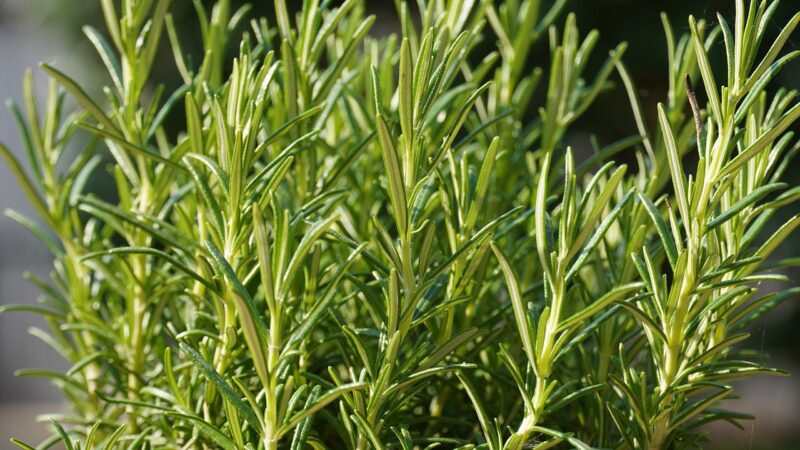The overwintering of rosemary

Successfully overwintering rosemary is a critical task for gardeners living in climates where winter temperatures fall below the plant’s natural tolerance. As a Mediterranean native, rosemary thrives in warmth and is not equipped to handle severe, prolonged freezes. The strategy for helping this beloved herb survive the cold months depends heavily on your specific growing zone and whether the plant is in a container or in the ground. For some, it may involve providing a protective layer of mulch, while for others, it will mean a seasonal migration indoors. Proper preparation and care during this dormant period are essential to ensure the plant not only survives but returns with vigor in the spring.
Assessing your climate and plant hardiness
The very first step in planning your overwintering strategy is to understand the climate of your specific region and the hardiness of the rosemary variety you are growing. The world is divided into horticultural zones based on average minimum winter temperatures. Most common rosemary varieties are hardy to about 20 degrees Fahrenheit (-6 degrees Celsius), making them suitable for year-round outdoor cultivation in zones 8 and warmer. In these milder climates, overwintering is a relatively straightforward process requiring minimal intervention.
However, there are specific cultivars of rosemary, such as ‘Arp’ and ‘Hill Hardy’, that have been bred for increased cold tolerance. These varieties can often survive temperatures down to 0 degrees Fahrenheit (-18 degrees Celsius), potentially making them viable for outdoor life in zones 6 or 7, especially if they are planted in a protected location. It is crucial to know which variety you have, as this information will directly inform your decision on whether to leave it outdoors or bring it inside. If you live in zone 5 or colder, no variety of rosemary is likely to survive the winter outdoors, and bringing it indoors is a necessity.
In addition to the average minimum temperature, consider the microclimates within your own garden. A rosemary plant situated against a south-facing wall will receive more warmth and protection from cold winter winds than one planted in an exposed location. This sheltered spot can sometimes make the difference between survival and demise in a borderline climate zone. Similarly, good soil drainage becomes even more critical in the winter, as cold, wet soil is far more damaging to the roots than cold, dry soil.
Therefore, a thorough assessment is required before winter arrives. Determine your USDA plant hardiness zone, identify the specific type of rosemary you are cultivating, and evaluate its location in your garden. This information will allow you to make an informed decision. For gardeners in zones 8 and above, you can likely prepare the plant for winter outdoors. For those in zones 7 and colder, you must seriously consider either providing significant protection or bringing the plant indoors for the season.
More articles on this topic
Preparing outdoor plants for winter
For gardeners in climates where rosemary can be left in the ground, a few preparatory steps in the autumn can significantly increase its chances of surviving the winter unscathed. The main goals are to insulate the root system and protect the foliage from harsh winds and extreme cold snaps. One of the most important actions is to apply a thick layer of mulch around the base of the plant. This should be done after the first hard frost of the season, as applying it too early can prevent the ground from cooling down naturally.
A layer of organic mulch, such as straw, shredded leaves, or bark chips, about two to four inches deep, will act as an insulating blanket for the roots. It helps to regulate the soil temperature, preventing the damaging effects of repeated freezing and thawing cycles. When applying the mulch, be sure to leave a small gap directly around the stem of the rosemary plant. Piling mulch up against the stem can trap moisture and lead to rot, so creating this small, clear space is an important detail for the health of the plant’s crown.
In addition to mulching, you should reduce watering as winter approaches. The plant’s growth slows dramatically in the cold, and it will use very little water. Cold, saturated soil is a major threat to the roots. In most cases, natural winter precipitation will be more than sufficient to meet the plant’s needs. Only provide supplemental water during extended dry periods, and do so on a milder day when the ground is not frozen solid.
For extra protection, especially in borderline zones or during periods of exceptionally cold weather, you can cover the entire plant. You can build a simple frame around the plant and cover it with burlap or a frost blanket. This will shield the foliage from damaging cold winds and heavy snow or ice. It is important to remove the cover during milder, sunny winter days to allow for air circulation and to prevent the buildup of heat and humidity, which could encourage fungal diseases.
More articles on this topic
Bringing rosemary indoors for the season
In colder climates (generally zone 7 and below), bringing rosemary indoors is the most reliable method for ensuring its survival. This process should begin in the autumn, well before the first hard frost is forecasted. If your rosemary is already in a container, the process is relatively simple. If it is planted in the garden, you will need to carefully dig it up and pot it in a container with excellent drainage, using a well-draining potting mix. Try to get as much of the root ball as possible to minimize transplant shock.
The transition from the outdoor environment to the indoors should be done gradually to avoid stressing the plant. A sudden change in light, temperature, and humidity can cause the plant to drop a significant number of its leaves. Start by placing the potted plant in a shady, sheltered outdoor location for a few days. Then, begin bringing it inside for a few hours at a time, gradually increasing the amount of time it spends indoors over the course of one to two weeks. This allows the plant to slowly acclimate to the lower light and humidity levels of your home.
Before you bring the plant inside for good, it is essential to inspect it thoroughly for any pests. The warm, dry environment of a centrally heated home is an ideal breeding ground for pests like spider mites and aphids, and a small problem can quickly become a major infestation. Check the stems and the undersides of the leaves carefully. It is a good practice to spray the entire plant with a gentle stream of water to dislodge any potential hitchhikers, and you may even consider a preventative spray with insecticidal soap or neem oil.
Once inside, place the rosemary in the sunniest and coolest location you can provide. A south-facing window is ideal, as it will provide the maximum amount of direct sunlight available during the short winter days. Cool temperatures, ideally between 40 and 60 degrees Fahrenheit (4 to 15 degrees Celsius), are preferable because they help to keep the plant in a semi-dormant state, reducing its need for light and water. Avoid placing it near heat sources like radiators or vents, which can dry out the plant very quickly.
Caring for rosemary indoors during winter
Caring for rosemary indoors over the winter presents a unique set of challenges, with the primary goals being to provide enough light while avoiding the pitfalls of overwatering and poor air circulation. Sunlight is often the most limiting factor. Even in a south-facing window, the intensity and duration of light during the winter are much lower than what the plant is used to outdoors. If the plant starts to look pale or leggy, you may need to supplement the natural light with a grow light, keeping it on for 10-12 hours per day.
Watering is the area where most indoor overwintering attempts fail. The plant’s growth is very slow during this semi-dormant period, so its water needs are drastically reduced. It is crucial to allow the soil to dry out completely between waterings. Check the soil moisture by inserting your finger a couple of inches deep; if it is even slightly damp, wait longer before watering. When you do water, do so thoroughly until water runs out the bottom, but then discard the excess from the saucer. Never let the pot sit in standing water.
The low humidity of a heated home can also be a challenge for rosemary, sometimes leading to dry, brittle needles. You can increase the humidity in the immediate vicinity of the plant by placing it on a tray filled with pebbles and water. As the water evaporates, it will create a more humid microenvironment. Misting the plant with water a few times a week can also be helpful, but this should be done in the morning to allow the foliage to dry during the day, which helps to prevent fungal issues.
Finally, good air circulation is important to prevent diseases like powdery mildew from developing. If the air in the room is very still, consider running a small, oscillating fan on a low setting for a few hours each day. This will help to keep the foliage dry and mimic the natural breezes the plant would experience outdoors. Do not fertilize the plant at all during the winter months. In the spring, when the danger of frost has passed, you can reverse the acclimation process and gradually reintroduce your healthy rosemary plant to the outdoors.
















